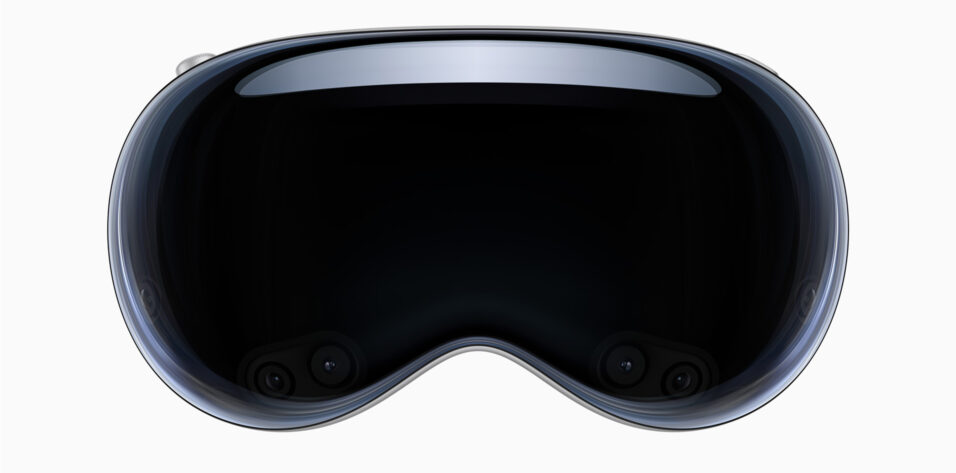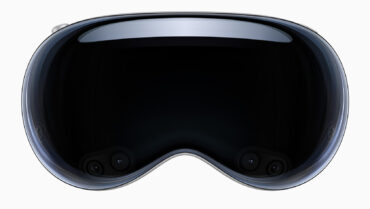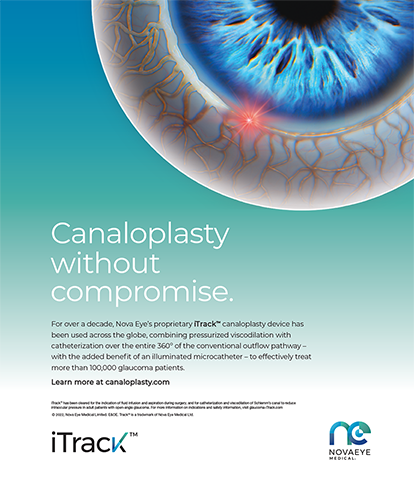
On June 5, Apple formally announced its first spatial computer, the Apple Vision Pro (Figure). Described as a 3D camera, the headset can immerse consumers in a seamless world of augmented and virtual reality (AR/VR) that offers an array of quality of life, accessibility and entertainment features that appear to outperform the functionality and image quality of previous AR/VR platforms.

Figure. The Apple Vision Pro.
(Courtesy of Apple)
Although the world of AR/VR has long existed, Apple’s entry into the market is worth noting because the company typically builds upon previously introduced concepts and refines features in new and innovative ways that lead to the highly polished and accessible feel of its products.
The implications and applications of AR/VR, AI, and machine learning in ophthalmology are profound and have been discussed in the literature. Ophthalmology is often at the forefront of adopting technological advances and integrating futuristic developments into daily clinical and surgical practice. This article explores the world of AR/VR, including the Vision Pro, and what it may signal for the future of ophthalmology.
THE CURRENT STATE OF AR/VR AND THE VISION PRO
Major companies such as Microsoft, Google, Meta, Sony, Samsung, Oculus, MagicLeap, and RadiusXR have invested heavily in the field of AR/VR headsets. Each company offers a unique product; price points and feature sets vary. The Vision Pro is poised to distinguish itself from competitors through the use of dual 4K micro-OLED displays, more than 12 cameras, iris scanning (termed Optic ID), and a myriad of additional technologies. These features combine to suggest an unparalleled level of immersion and accessibility, potentially redefining expectations for AR/VR capabilities.
The Vision Pro presents opportunities to enhance patient education and the management, diagnosis, and treatment of ocular pathology.
IMPLICATIONS FOR THE REFRACTIVE SURGERY MARKET
As a refractive surgeon, I encounter patients who seek independence from glasses and contact lenses through laser vision correction, phakic IOL implantation, and refractive lens exchange (RLE). These individuals have diverse backgrounds, professions, and hobbies as well as unique motivations for pursuing surgical intervention. Some patients routinely use AR/VR headsets and experience difficulties related to their eyewear. Glasses can hinder a smooth AR/VR experience if they are jostled during headset adjustment or removal, and extended use of contact lenses may result in dry eyes and irritation.
The recent announcement of the Vision Pro highlighted a collaboration with Carl Zeiss Meditec for the provision of optical inserts for refractive error correction that are to be sold separately upon product launch. Initial reports from those who have hands-on experience with the device describe the process of refraction and fitting with trial lenses or the use of a lensmeter to select lenses corresponding to their existing spectacle correction. It is conceivable that future AR/VR headsets may integrate autorefractors, eliminating the need for glasses, contact lenses, or other vision correction means. The technology required to achieve this, however, has not yet been realized.

If Vision Pro and other AR/VR technologies gain widespread adoption, it could increase the demand for refractive surgery. A parallel may be found in the surge in refractive surgeries observed during the COVID-19 pandemic. The demand for surgical vision correction rose in response to factors such as the fogging of spectacle lenses from wearing masks, frequent viewing of oneself during videoconferencing, hygiene concerns related to contact lens handling, and an increase in disposable income from government stimulus checks and reduced spending on travel and entertainment.
If virtual meetings, television and movie viewing, internet browsing, social media consumption, and video gaming increasingly shift to AR/VR platforms, a similar rise in demand for refractive surgery may follow.
PATIENT EDUCATION STRATEGIES FOR RLE AND CATARACT SURGERY
A major challenge during preoperative counseling for cataract surgery or RLE is setting realistic expectations. Educating patients about various IOL technologies and different refractive targets is complex. Refractive errors and diminished contrast sensitivity due to cataracts can make it hard for them to appreciate visual descriptions and demonstrations of possible postsurgical results.
The SimVis Gekko (2EyesVision) is a device that enables patients and their families to trial the vision that a given IOL is designed to provide before surgery, and more simulators are in development. Questions remain about how much a cataract may affect the quality of the trial, but in a recent study, the pre- and postoperative perceptions of patients with high objective scatter index readings who used the device compared favorably.1
AR/VR technology, including the Vision Pro, is well positioned for similar applications. It could also offer native capabilities for presenting educational videos and animations about cataract pathophysiology, the surgical procedure, the logistics of the surgery day and recovery, and financial counseling. The system’s eye-tracking feature might even be able to simulate a digital potential acuity meter, enabling assessments of expected postoperative vision in patients with dense cataracts.
APPLICATIONS FOR THE DIAGNOSIS AND MANAGEMENT OF OPHTHALMIC DISEASE
The implications for the diagnosis and management of ophthalmic disease through AR/VR headsets are immense.
Visual field testing and home-based data collection. Along with other features such as digital contrast sensitivity and Amsler grid testing, the RadiusXR (RadiusXR) already serves as a validated visual field device with performance similar to that of traditional visual field testing. The implications of a patient’s having their own device and being able to perform a visual field test at their leisure or desired or designated frequency cannot be overstated.
IOP checks and stereoscopic images with Apple Vision Pro. Devices such as the iCare Home tonometer (iCare USA) allow patients to check their IOP at home. A patient with a set of dilating drops could use the Vision Pro as a fundus camera and take stereoscopic images of their optic nerves at home. The IOP readings, visual field tests, and stereoscopic fundus photographs could then be sent digitally to their ophthalmologist, who could interpret the data and contact the patient for follow-up.
Potential applications for diabetic and hypertensive retinopathy, ocular melanoma, cataract, and refractive error. Similar applications could exist for the periodic observation of patients who have diabetic or hypertensive retinopathy or ocular melanoma as well as for measuring cataract progression and changes in refractive error. Fitness trackers can measure and detect irregular changes in heart rate, the heart’s electrical activity, and sleep patterns and transfer that information to the wearer’s physician. It is conceivable that something similar could be established in ophthalmology where visual fields, fundus photographs, and the equivalent of slit-lamp photographs can be remotely assessed by an ophthalmologist or AI.
Children’s amblyopia management and accessibility features in visionOS. Amblyopia management in the form of eye patching for children is another potential application. Apple has long been a champion of accessibility for individuals with hearing or visual impairment. The Vision Pro could allow features already present on Apple’s iOS and iPadOS, such as manipulation of contrast sensitivity, to come to its visionOS.
THE DARK SIDE OF VIRTUAL COMPUTING
Some caveats related to eye health and user experience must be considered aside from broader implications such as potential social isolation. The decrease in blink rate during activities such as watching TV or using digital devices is well documented. Extended AR/VR use may exacerbate dry eye disease and contribute to myopic progression. Whether optical inserts, contact lenses, or laser vision correction can mitigate these risks remains to be seen. Additionally, concerns about ergonomics, motion discomfort, image misalignment, and vergence-accommodation conflict are challenges Apple and other companies must address.
BOTTOM LINE
Apple’s foray into the AR/VR sphere is poised to drive growth and innovation in the market, which could benefit consumers, patients, and the field of ophthalmology. The industry is well positioned to leverage new applications for surgical education, diagnosis, and the management of ocular pathology. The intersection of technology and eye care offers exciting possibilities, but attention to the potential drawbacks is crucial to maximizing their positive impact.
1. Barcala X, Zaytouny A, Rego-Lorca D, et al. Visual simulations of presbyopic corrections through cataract opacification. J Cataract Refract Surg. 2023;49(1):34-43.




